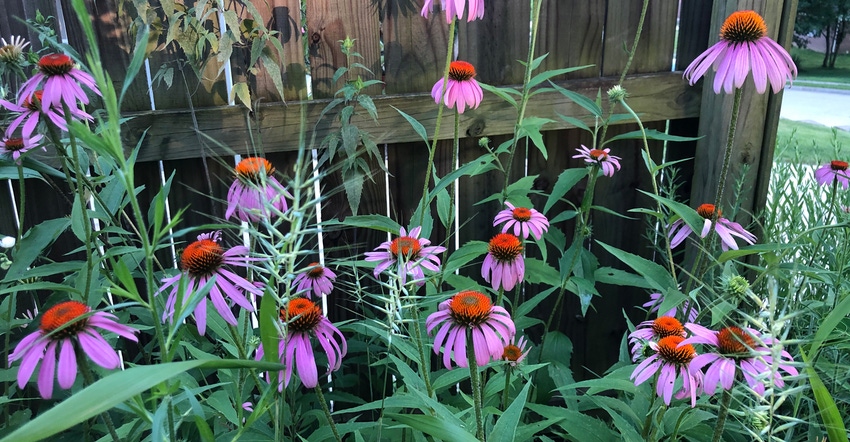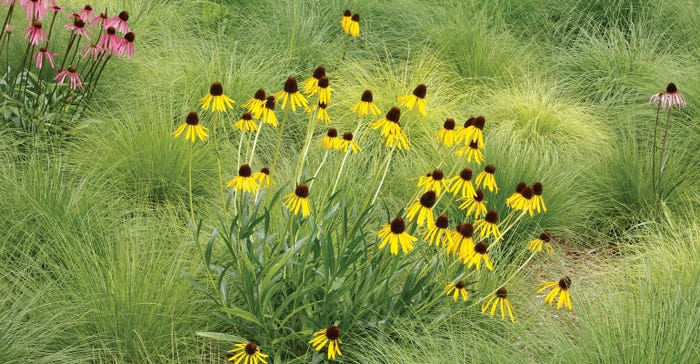May 14, 2021

Echinoderms and Echinacea resemble each other. However, one is in the sea, and the other is on land.
Echinoderms, or sea urchins, are spiny crustaceans that live on the ocean bottoms. Echinacea, or coneflowers, are spiny “asters” that live on dry land. They aren’t actually asters, but are in the Aster family of plants, like blazing star, black-eyed Susan, goldenrod and ironweed. Echinacea have prickly seed heads that look like sea urchins.
When I collect dried coneflower seed heads, I’m instantly reminded why they are named after a spiny sea creature — they are sharp to the touch! But that doesn’t stop various animals from eating them.
Mice scale the skinny seed head stems to the top, and like coconut farmers, cut the seed heads off. When the seed heads are on the ground, mice dismantle them and gather the nutritious kernels of seed to live off of through winter.
Goldfinches and other seed-eating birds aggressively shred purple coneflower seed heads in search of the same highly sought-after kernels. White-tailed deer — which must have tongues like leather — eat the entire seed heads in fall.
In the past, humans used the seeds to induce a numbing effect. I don’t recommend you try this, but if you must, a single chewed (and spat out) seed will demonstrate the power of its numbing effect.
Start with the seed
Wearing leather gloves, gardeners collect the spiny seed heads in order to grow more purple, yellow, pale purple and glade coneflowers.
These are straight species. They all are tap-rooted, clump-forming perennials. The flowers of straight species attract bumblebees, sweat bees, honeybees, moths, butterflies, skippers and wasps, as well as insect predators such as wheel bugs and praying mantises that show up to ambush the pollinators.
Pollinators eat and gather pollen and nectar from fully functioning flowers, and in the process, inadvertently move pollen from the anther (male flower that produces yellow or white pollen) to the stigma (part of the female flower that is sticky to catch pollen). This results in seed production.

MANY COLORS: The coneflower comes in many different colors from pale purple to bright yellow.
In over 40 years of gardening, I have never seen a straight species coneflower take over a garden from seed. They are short-lived perennials at best.
Of the coneflowers, purple coneflower spreads the most. Even though finches seem to eat every purple coneflower seed on every seed head, some seeds are missed and fall to the ground where they produce a few new plants the following April.
This is by no means an overwhelming number of plants. They pop up here and there, often in surprising places, probably moved around by mice.
Plant breeders, however, endeavor to improve coneflowers by mixing (or crossing) different species together into something new, referred to as a hybrid cultivar. That’s why there are Echinacea cultivars in every shade of purple, red, orange, yellow and even green. And why most of them — but not all —are sterile, producing no pollen or nectar, and therefore attract no pollinators. They do not produce seeds, nor do they attract seed-eating birds. They are fully nonfunctioning flowers with one exception. They function for humans, who enjoy looking at them.
Types of coneflowers
Of all the straight Echinacea species, glade coneflower is the most finicky, requiring well-drained soil, preferably rocky soil on a south- or west-facing slope, and full sun. It will also survive for a few years along the edge of a driveway or sidewalk with a gravel base. Remember, they need drainage and rocks to thrive.
Yellow coneflower and pale purple coneflower are easier to grow than glade coneflower. They do fine in well-drained soils on a slope in full sun. If you have rocky soil with exposed boulders (natural boulders), they will live long and prosper, but most of us aren’t so lucky to have rocks in the yard. In regular garden soil, which has a lot of clay, they benefit from a mound of topsoil (a berm) or a steep slope.
Plant them at the top where the soils are driest — not at the bottom where the soils are moister. And remember, they are short-lived perennials at best. That means that they will live a few years and then die. Learn to look for seedlings that pop up in the garden in April (they look like long, hairy bunny ears), or grow them indoors from seed in a sunny window.
Either way, get used to the ebb and flow of certain species that come and go. These short-lived perennials are worth the extra effort, so whatever you do, don’t give up on prickly coneflowers. You will be rewarded by the feeding frenzy that shows up in your yard every summer and fall.
Woodbury is a horticulturalist at the curator of the Whitmire Wildflower Garden at Shaw Nature Reserve in Gray Summit, Mo. He also is an adviser to the Missouri Prairie Foundation’s Grow Native! program.
About the Author(s)
You May Also Like




